英汉互译简明教程-Translation Techniques
翻译课程 第8讲 正说反译和反说正译
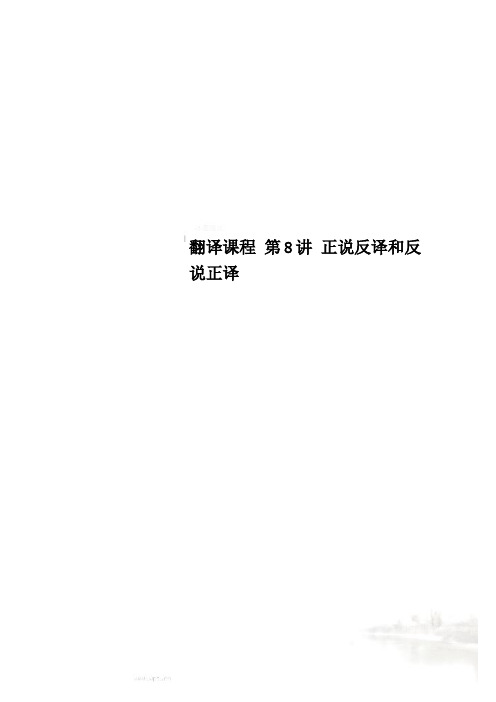
翻译课程第8讲正说反译和反说正译广西师范学院《英汉互译(一)》课程教案编号: 15-8 开课单位:外语系授课教研室:翻译写作课程名称:《英汉互译(一)》授课教师:唐旭光教材:《新编英汉互译教程》,授课对象:06级英语专业2、3、5班《英汉互译(一)》第八讲正说反译与反说正译(Conversion Between Positive and Negative Expressions)17. He reminded me of what I should otherwise have forgotten.他提醒了我,要不然我就会把这事忘了。
7. 原文中的介词在译文里从反面表达18. The book is beyond the knowledge of a five-year-old child.这本书五岁孩子读不懂。
19. I am embarrassed to write of “God’s presence”. God is off my beat.我决不会就“上帝的存在”挥笔撰文,上帝不属于我工作的范围。
20. Child-development experts warn parents against placing unreasonable expectations on school-age children.儿童成长专家警告说,家长不要对学龄儿童寄予不合理的期望。
21. How delightful it would be, I thought, to have months of clean snow and a landscape sparkling with frost instead of innumerable gray featureless days of rain and raw winds.我想,如果我们这里经常是个冰雪积月、霜华璀璨的景色,而不是像现在这种苦雨凄风永无尽期的阴沉而乏特色的日子,那该会多么令人喜悦啊!22. His behavior is above praise.他的行为不止是值得称赞的。
实用英汉互译教程4 Basic Translation Skill Conversion
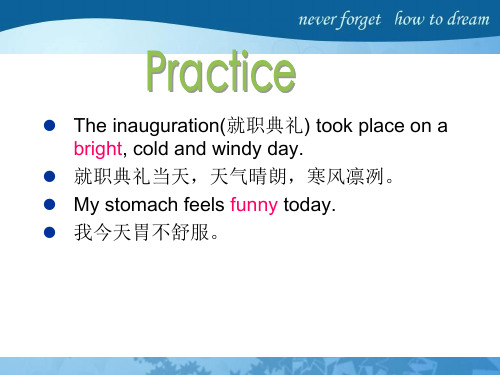
2. 介词转译成动词(prep.---v.)
英语中介词的使用频率相对于汉语来说要高得多 。实际上英语中很多介词在语境中可带有明显的 动作意味,例如“across, against, past, toward, through, with”等。因此在翻译的过程中为了汉语 表达的通顺流畅,可以根据具体情况将一些介词 转译为动词。
4. 副词转译为动词(adv.---v.) 英语中,副词常常用来修饰动词作状语,这样使 得副词具有了动作意味。所以,副词也可以转换 为汉语的动词来翻译。 We started home. 我们启程踏上归途。 The train will be in in ten minutes. 火车十分钟后会到达。
2. 介词转译成动词(prep.---v.)
“Coming!” Away she skimmed over the lawn, up the path, up the steps, across the verandah(凉台), and into the porch(门廊).
“来啦!”她转身蹦跳着越过草地,跑上小径,跨 上台阶,house with the money. 他用那笔钱买了一栋房子。 Both the police and the murderer are after him. 警察和凶手都在找他。 He was finally on his feet again. 他终于又站了起来。 Are you for or against the proposal? 你赞成还是反对这项提案?
be flooded with people 战争前夕,这个火车站被逃难者所淹没。 Before the war, the train state was flooded with refugees. be all packed 体育馆被塞得满满当当。 The stadium was packed with so many people. The stadium is all packed.
Chapter 5 Translation techniques (II)47页PPT

• The group’s liquid funds, inflated by the record profits of the past two years, climbed to eighteen point two five billion Swedish kronor by the end of the first quarter from fourteen point four billion Swedish kronor a year earlier.
重复动词
• We talked of ourselves, of our prospects, of the journey, of the weather, of each other— of everything but our host and hostess.
• 我们谈到自己,谈到前途,谈到旅程,谈 到天气,谈到彼此的情况——谈到一切, 只是不谈我们的男女主人。
• 尽管其汽车的销售量有了大幅度的增长, 沃尔沃的营业额却下跌了5%,从去年前三 个月的218亿瑞典克朗下降到206亿瑞典克 朗。
• Turnover: the total business done by an organization in a given period.
• 营业额,成交量
• An annual turnover of $10 million. • 全年营业额1,000万美元。
• 财经项目的利润增长达到24.5亿瑞典克朗(3 亿1500万美元),而去年同期则为22.1亿瑞典 克朗。
• The group was helped by a two hundred and fifteen million Swedish kronor foreign-exchange gain on loans—compared with a gain of thirty million Swedish kronor a year earlier—as well as by interest earnings of a hundred and nine million Swedish kronor—compared with seventy-seven million Swedish kronor in the first quarter of last year.
英汉互译简明教程TranslationTechniques-2023年学习资料

Choice of Word Meaning-In the practice of translation what perplexes us most-frequently is how to find an e uivalent in the language to-be translated into.Great are is called for in the-translation of "familiar"Eng ish into Chinese,as their-meaning vary with the chang in collocation or context.-By diction,generally spea ing,the following are some-commonly-used ways availab e to find an equivalent in-the TL.
Word Meanings-Conceptual Meaning:is the basic meaning and-the main information carried by linguistic signs. e.g.No smoking禁止吸烟-Stylistic Meaning:is communicated f the social-circumstance of language use.
Linguistic Meaning:is built on the relationships of-t e signs with each other in the same system.-e.g.-千山鸟飞 ,From hill to hill no bird in fight.-万径人踪灭。From path o path no man in sight..-■-Pragmatic Meaning:is the s udy of the "relation of-signs to interpreters".-大家见面, 呼声“吃了吗?”透着和气。-They greet with each other with a "Hi"j st to show their-good neighbourly feelings.-年夜饭-famil reunion meal on the eve of the Spring Festival
Translation techniques(里面包含增译法,减译法,转译法,重复译法)

❖ 英语和汉语在语法方面差异很大, 比如英语有数的 变化、有时态、语态、语气变化、有情态的变化 (我们常称为三态一气),而汉语这样的变化很少, 如时态,只用着、了、过就解决了。在翻译中我们 要注意这些差别, 把英语中的数和三态一气等体现 出来。为了使译文忠实地表达原文的意思与风格并 使译文合乎表达习惯,必须增加一些词语,这就叫增 译法.
❖ Let’s revise our safety and sanitary regulations. ❖ 我们来修改安全规则和卫生规则吧。
❖ Gentlemen may cry, peace, peace --- but there is no peace.
❖ 先生们尽管可以高呼和平,和平!但是依然没有和 平。
nothing. ❖ 他的那些孩子,也是穿得破破烂烂,粗野不堪,就象没有父
母似的。 ❖ His children, too, were as ragged and wild as if they
belonged to nobody.
Examples
❖ We have to analyze and solve problems. ❖ 我们要分析问题,解决问题。
1. Repetition(重复法)
❖ (3)为了生动重复
根据两种语言各自的习惯用法,以不同的 表达方式进行重复,这种重复通常是为了传达 原文的生动性.
❖ 汉语中有大量四字词组,这是汉语的一在特点。四 字词组比较精炼,念起来顺口,有节奏感,在英译 时要注意词汇的选择,尽量保留原文生动活泼的修 辞效果。例如:
1. Repetition(重复法)
❖ 他老是磨磨蹭蹭,马马虎虎,脾气又好得惊人,我们都对他 毫无办法。
❖ With his tardiness, careless and appalling good temper, we had nothing to do with him.
英汉互译简明教程(第二版)课件8 第二篇 长句翻译
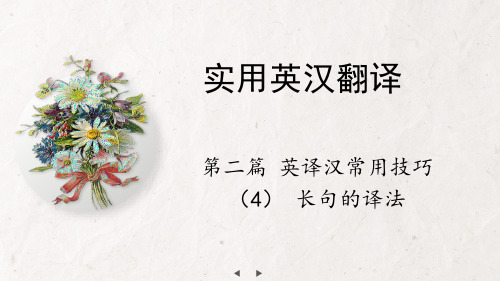
译文:由于人民生活水平的不断提高以及计划生育,中国的家庭
3
结构发生这缓慢却又具有实质性的变化,必须根据这一历史背景
2
1
考虑人到老年的问题。
11
变序法
3. I consider a human soul without education, like marble in the quarry, which shows none of its inherent beauties, until the skill of the polisher fetches out the colors, makes the surface shine, and discovers every ornamental cloud, spot and vein that runs through the body. (P109)
15
分句法
6. Having just left school or technical institute, where they had their place and a task to fulfill and where they were known and esteemed by their colleagues, those young people who do not land that first job they were so eagerly looking forward to have to face up for the first time to unemployment, a situation for which neither family nor school has prepared them. (P111-112)
英汉互译3-conversion

UNIT 3 CONVERSIONConversion, one of the commonly adopted translation techniques, means the change of parts of speech in translation.Owing to the syntactical differences between English and Chinese, it is usually impossible for a translator to keep to the original part of speech in the process of translation.For example:This watch neve r varies more than a second in a month.这块表一个月的误差从不超过一秒钟。
The English verb “vary” can hardly be rendered into Chinese by the same part of speech without spoiling the original meaning.In fact, a word belonging to a certain part of speech in one language sometimes has to be converted into a different part of speech, so as to bring forth a readable and coherent sentence.I. Conversion in English-Chinese Translation1. Converting into VerbsOne of the most remarkable differences between English and Chinese syntax is the use of the verb. It is taken for granted that an English sentence contains no more than one predicate verb, while in Chinese it is not unusual to have clusters of verbs in a simple sentence.Families upstairs have to carry pails to the hydrant downstairs for water.住在楼上的人家得提着水桶去楼下的水龙头打水。
郭著章、李庆生《英汉互译实用教程》(第3版)课后习题及详解-第3、4章【圣才出品】
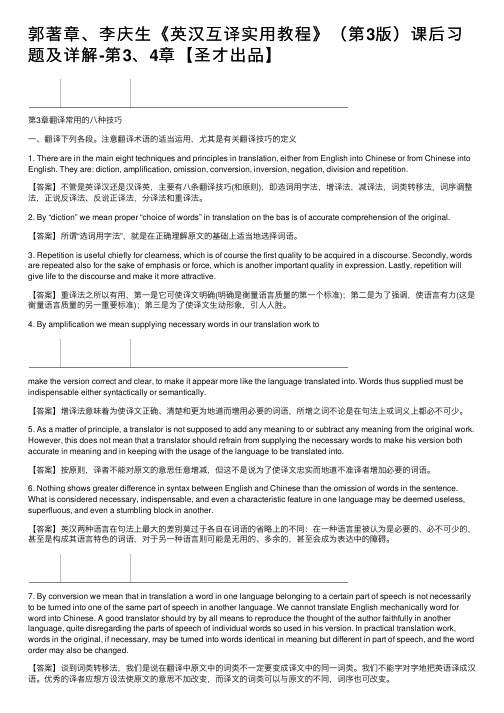
郭著章、李庆⽣《英汉互译实⽤教程》(第3版)课后习题及详解-第3、4章【圣才出品】第3章翻译常⽤的⼋种技巧⼀、翻译下列各段。
注意翻译术语的适当运⽤,尤其是有关翻译技巧的定义1. There are in the main eight techniques and principles in translation, either from English into Chinese or from Chinese into English. They are: diction, amplification, omission, conversion, inversion, negation, division and repetition.【答案】不管是英译汉还是汉译英,主要有⼋条翻译技巧(和原则),即选词⽤字法,增译法,减译法,词类转移法,词序调整法,正说反译法、反说正译法,分译法和重译法。
2. By “diction” we mean proper “choice of words” in translation on the bas is of accurate comprehension of the original.【答案】所谓“选词⽤字法”,就是在正确理解原⽂的基础上适当地选择词语。
3. Repetition is useful chiefly for clearness, which is of course the first quality to be acquired in a discourse. Secondly, words are repeated also for the sake of emphasis or force, which is another important quality in expression. Lastly, repetition will give life to the discourse and make it more attractive.【答案】重译法之所以有⽤,第⼀是它可使译⽂明确(明确是衡量语⾔质量的第⼀个标准);第⼆是为了强调,使语⾔有⼒(这是衡量语⾔质量的另⼀重要标准);第三是为了使译⽂⽣动形象,引⼈⼈胜。
六、翻译技巧(2)词类转换法
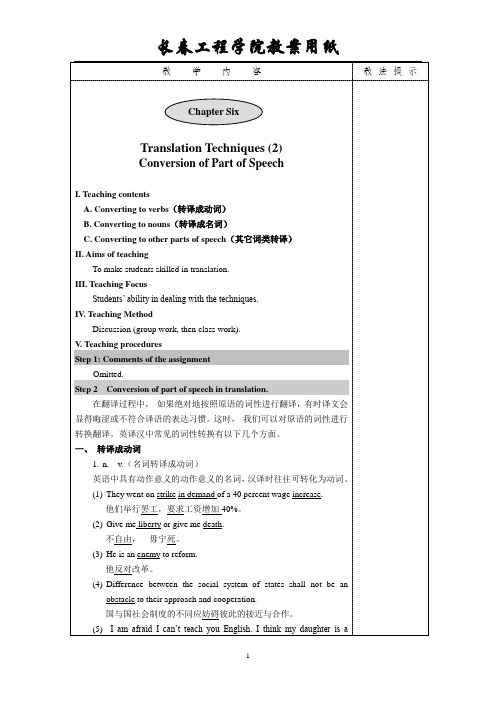
3
长春工程学院教案用纸
他的讲话给我留下很深的印象。 From the front, back and both sides we kept a strict watch on the enemy. 我们在前后左右严密地监视敌人。 He is the right man I’m looking for. 他正是我在找的人。 The unit of weight is the gram, that of length is the meter, and that of capacity is the liter. 重量单位是克,长度单位是米,容量单位是升。 The machine can dimensionally be changeable according to consumers’ need. 机器的在大小(或尺寸)可以根据用户的需要改变。 All you have done is proportional to all you have achieved. 你的付出和所得成正比。 To be independent is an absolute necessity for young people. 独立对年轻人来说是绝对必要的。 10. In science, it is important to state a law or a principle accurately. 在科学方面定律或定理的准确叙述十分重要。 11. With slight repairs, the machine could be in motion. 只要称加修理,这台机器便可以运转。 12. The new mayor earned respect due to the courtesy of visiting the poor in the city. 新市长有礼貌地访问城市贫民赢得了人们的尊敬。 Step 3 Assignment Put the following into English, paying special attention to the selection of words. 大自然对人的恩赐, 无论贫富, 一律平等。 所以人们对于大自然大全 都一致并深深地依赖着。 尤其是在乡间, 上千年来人们一直以不变的 方式生活着。 种植庄稼和葡萄, 酿酒和饮酒, 喂牛和挤奶, 锄草和 栽花; 在周末去教堂祈祷和做礼拜, 在节日到广场拉琴、跳舞和唱歌; 往日的田园依旧是今日温馨家园。这样,每个地方都有自己的传说, 风 俗也就衍传了下来。 说明:本题是 2002 年全国英语专业八级考试汉译英试题。翻译时在以下 三个方面请特别注意: 1. 词汇的选择, 包括词义的理解和词的搭配。 2. 词序。 3. 语篇层次。
英汉互译6-restructuring
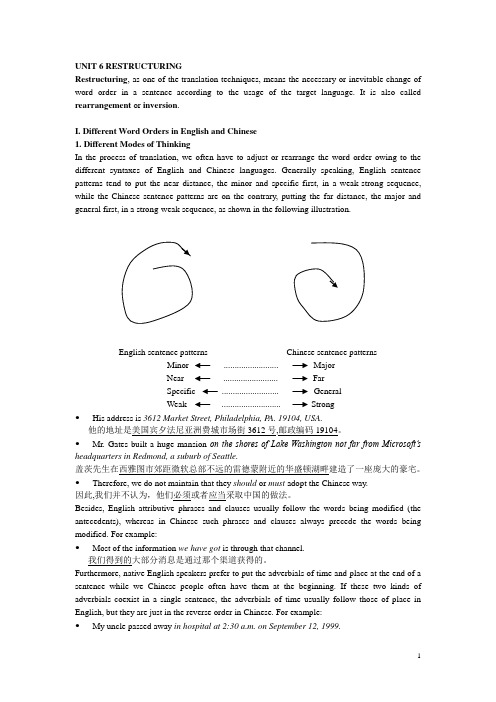
UNIT 6 RESTRUCTURINGRestructuring, as one of the translation techniques, means the necessary or inevitable change of word order in a sentence according to the usage of the target language. It is also called rearrangement or inversion.I. Different Word Orders in English and Chinese1. Different Modes of ThinkingIn the process of translation, we often have to adjust or rearrange the word order owing to the different syntaxes of English and Chinese languages. Generally speaking, English sentence patterns tend to put the near distance, the minor and specific first, in a weak-strong sequence, while the Chinese sentence patterns are on the contrary, putting the far distance, the major and general first, in a strong-weak sequence, as shown in the following illustration.English sentence patterns Chinese sentence patternsMinor ......................... MajorNear ......................... FarSpecific .......................... GeneralWeak ........................... Strong•His address is 3612 Market Street, Philadelphia, P A. 19104, USA.他的地址是美国宾夕法尼亚洲费城市场街3612号,邮政编码19104。
1-5:英汉互译实践与技巧
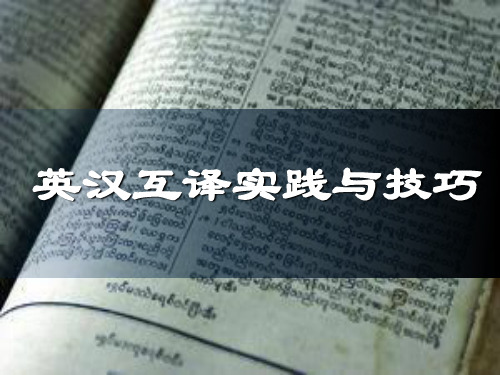
Ⅱ. Nature and Scope of Translation 翻译的性质和范围
类别:
语言 native foreign、 foreign native 工作方式 口译(interpretation)、笔译(translation)、机器翻 译(MT) 口译:连续传译(consecutive interpretation)、同声 传译(simultaneously interpretation) 文体 应用文体、科技文体、论述文体、新闻文体、艺 术文体
处理方式 全译、节译、摘译、编译、译述(综述和述评)
Ⅲ. Principles or Criteria of Translation 翻译的原则和标准
Principle原则:
严复:信,达,雅(faithfulness, expressiveness, elegance) 鲁迅:易解、保持原作的风姿 林语堂:忠实、通顺、美 傅雷:神似说(spiritual conformity) 钱钟书:化境说 (sublimed adaptation) 许渊冲:三美说(意美、音美、形美) 泰特勒Tytler :翻译三原则 费道罗夫等:等值论 (translation equivalence) 奈达:读者反应论 (dynamic equivalence)
Nature性质:
Ⅱ. Nature and Scope of Translation 翻译的性质和范围
Translation is not a word for word activity
1、她现在非常红. *She is very red now. (She is very popular now.) 2、你给我站住!*You Give Me Stop!! (Stand!) 3、蠢蠢欲動。 *Stupid stupid want to move . (Be ready to do sth.(bad)) 4、寒暄 *coldly talk for a while (to exchange greetings and make small talk ) 5、跳伞处 *"Site of jumping umbrella" (paragliding site) 6、请爱护花草* "Cherishing Flowers and Trees" (keep off the grass.)
英汉互译简明教程-Translation Techniques

•
• • • • • • • • • • • •
Definition of amplification
Diction is one of the basic translation techniques to express meaning by using the proper choice of words and phrases. It must be based on the accurate comprehension of the original.
•
In practice, words are actually classified into three categories as :
colloquial(口语) 2)common (常用语) 3)formal (书面语).
1) 2) 3)
Take “wife” for instance: Colloquial: woman, old woman, better half Common: wife Formal: consort, spouse, helpmate.
4.1 Diction
Teaching Contents:
•
Word Meaning
Conceptual Meaning Stylistic Meaning Linguistic Meaning Pragmatic Meaning
•
• •
• •
Choice of Word Meanings
Choice of Word Meanings According to Their Parts of Speech Choice of Word Meanings According to Different Collocation. Choice of Meaning Shifts Between the Abstract and the Concrete. Choice of Affective Meanings. Choice of Contextual Meanings Special Techniques Employed in Translating a word. Deduction(推演法) Transplant(移植法) Extension(引申法) Substitution(替换法) Explanation(释义法) Combination(合并法) Pictographic(图形法) Transliteration(音译法) Zero-Translation(零翻译法) Transliteration + Explanation(音义结合法)
翻译汉译英课件翻译技巧Translationtechniques

1. Repetition(重复法)
重复也属于增词。翻译和写作一样。 本应力求简 练,尽量省略一些可有可无的词;有时为了明确、 强调或生动, 却往往需要将一些关键性的词加以 重复。例如: (1)为了明确重复
汉语重复,英ห้องสมุดไป่ตู้时也重复
(2)为了强调重复 为了强调,汉语句子中往往重复关键性的词,以 使读者留下深刻印象,汉译英时往往可以采用同 样的重复手段。 汉语原文中有词的重复,译成英语时可以保持同 样的词的重复。
1为了明确重复?汉语重复英译时也重复?2为了强调重复为了强调汉语句子中往往重复关键性的词以使读者留下深刻印象汉译英时往往可以采用同样的重复手段
Translation Techniques
Teaching Plan
Teaching Contents:
1. Introduction to the functions of translation techniques 2. Introduction to the 8 commonly-used techniques 1) repetition(重复法) 2) amplification(增译法 ) 3) omission(/省译法/减译法 ) 4) conversion(词类转移法 ) 5) inversion (词序调整法) 6) division(分译法) 7) negation(正说反译, 反说正译法) 8) the change of the voices(语态变换法)
Eight Commonly-used Translation Techniques
1. repetition(重复法) 2. amplification(增译法 ) 3. omission(/省译法/减译法 ) 4. conversion(词类转移法 ) 5. inversion (词序调整法) 6. division(分译法) 7. negation(正说反译, 反说正译法) 8. the change of the voices(语态变换法)
1-5:英汉互译实践与技巧 (课堂PPT)

crocodile tears 鳄鱼的眼泪; armed to the teeth 武装到牙齿; chain reaction 连锁反应; gentlemen’s agreement 君子协定 one country, two systems 一国两制; The three religions and the nine schools of thought 三教九流; paper tiger 纸老虎; go to one’s eternal rest 安息;the long sleep 长眠; see Marx 见马克思;go west 上西天; go to heaven 上天堂;
理解 Comprehension :comprehend the source text completely
表达 Expression:render the source text into the target language text (a rough translation)
校正 Proofreading:proofread the rough translation & polish
许建平 《英汉互译实践与技巧》清华大学出版社 2006年 郭著章、李庆生《英汉互译实用教程》武汉大学出版社
1996年 张培基 《英汉翻译教程》上海外语教育出版社 1980年 张光明 《英语实用文体翻译》中国科学技术大学出版社
2009年 连淑能 《英汉对比研究》高等教育出版社 1993年 李瑞华 《英汉语言文化对比研究》上海外语教育出版社
7
Ⅱ. Nature and Scope of Translation 翻译的性质和范围
英 国 翻 译 教 育 家 Peter Newmark : “ It is rendering the meaning of a text into another language in the way that the author intended the text. 翻译是按作者的创造意图把一篇文章的意思 用另一种语言描述出来的过程。”
TranslationTechniques解读

Jordan can not politely turn down the invitation to an Arab foreign ministers conference.
约旦假设拒绝承受阿拉伯外交会议的邀请,在礼貌上 说不过去。
一个举目无亲的孩子,而且他父亲当时是认为 我会待他好才把孩子托给我的,我总不能打他 吧。
I couldn”t beat a boy who hadn”t got a relation in the world and whose father had left him to me because he though I”d be kind to him.
During his visit to China, the Korean foreign minister conferred with his Chinese counterpart a number of times.
在中国访问期间,韩国外交部长与中国外交部进步行了 数次会商。
Potatoes are an important source of starchy food in temperate countries and bananas in tropics.
为什么总是把这些麻烦事都推给我呢?
Why should all the unpleasant jobs be pushed on to me?
6. 英汉句子叙事、推理的挨次大局部状况下是 相反的。英语句子在叙事时往往先说最近发生 的事,再说从前发生的事;汉语则相反。英语 句子先总提,然后才表达所发生的事情,汉语 则先说事,后总结。
His weariness and the increasing heat determined him to sit down in the first convenient shade.
简明翻译教程

能够每天坚持收听VOA的Newsnow,Ourworld,BBS的24 Hour News和CNN的相关新闻广播。
如果辅助北外的Listen 2 This高级本是最好的了。
Week 01 简明翻译教程翻译的定义:翻译是许多语言活动中的一种,它是用一种语言形式把另一种语言形式里的内容重新表现出来的语言实践活动。
这一活动分为口头与书面两种。
(Interpretation and translation)有时在不同国家的不同语言之间进行,有时在同一国家的不同民族或不同区域的语言之间进行,但这种实践活动更多的应用于前者。
翻译是一门艺术,是语言艺术的再创作。
一篇译文在定稿之前,一般都要经过许多次修改,才能达到较高的水平。
一部名著经常会有树种译本并存。
一个译本的反复修改,同一原著的各有千秋的不同译本,都体现了翻译的艺术性。
如果说把写作比成自由舞蹈,翻译就是带着手铐脚链在跳舞,而且还要跳得优美。
因为原著的创作不受语言形式的限制,而翻译既要考虑到对原著的忠实,又要按照译文的语言规则来表达原文的意思。
从这个意义上来将,翻译并不比创作容易,有时甚至更难。
翻译的目的:世界语言繁多,导致了翻译的必要性。
我们翻译课的开设,其目的就是在掌握汉语和英语这两种语言的基础上,结合不断的翻译实践,学习翻译中的各种技巧,提高翻译水平。
通过翻译,对已经掌握的听、说、读、写的能力可以进行一次全方位的检验,找出漏洞,弥补不足,并使这些能力在综合运用中得到巩固和提高。
学习英语的主要目的是搞翻译,而翻译又可以反过来进一步促进英语学习。
翻译的标准:早在汉朝和唐朝,就有“文”与“质”之争。
文就是强调翻译的修辞和通顺,可读性。
质强调翻译的不增不减,忠实性。
体现了意译和直译之争,但有片面性。
1898年,严复(《天演论》)提出的“信”、“达”、“雅”,即忠实原文、文字典雅。
(适合部分文学作品)1951年,傅雷提出文学翻译应该“传神”论,“以效果而论,翻译应当像临画一样,所求的不在形似而在神似。
英汉互译

The Spring DawnSlumbering, I know not the spring dawn is peeping,But everywhere the singing birds are cheeping.Last night I heard the rain dripping and wind weeping,How many petals are now on the ground sleeping.Mounting the Stock TowerThe white sun sets behind mountains,The Yellow River flows into the sea.Go further up one flight of stairs,And you’ll widen your view a thousand Li.Chapter 6 Differences Between Chinese And English1.writing system:Chinese: ideographic system (表意文字)English: alphabetic system (表音文字)1.family:C: Sino-Tibetan familyE: Indo-European family2.type:C: analytic E: syntheticFineness3.tone:C: tone language E: intonation language5. Relationships between the vocabularies of the two languages1)Correspondence: proper names, nounsoverall strength of the country, to pay sb. IOU, 知识产权false correspondence:淡水,salt solution 盐水,学习知识acquire knowledge,强硬政策tough policy,好票,穷山恶水barren mountains AND untamed rivers 2)Inclusion: 胡子(moustache, whiskers, beard),beauty (beauty contest, beauty shop, beauty specialist,the magazine's beauty editor)3)Intersection:骑墙fence-sitter ,票:请买票。
- 1、下载文档前请自行甄别文档内容的完整性,平台不提供额外的编辑、内容补充、找答案等附加服务。
- 2、"仅部分预览"的文档,不可在线预览部分如存在完整性等问题,可反馈申请退款(可完整预览的文档不适用该条件!)。
- 3、如文档侵犯您的权益,请联系客服反馈,我们会尽快为您处理(人工客服工作时间:9:00-18:30)。
•
Version1: 他的眼睛热情,凶猛又明亮,胡子又稀又粗。 Version2: 他的眼睛热情,锐利,炯炯有神,胡子稀疏 粗硬
Special Techniques Employed in Translating a Word.
•
1.Deduction(推演法)
Deduction is to deduce the original meaning in the light of the explanation of an English dictionary.
e.g. If you dare to play the fox with me,I’ll shoot you at once
你要是敢和我耍滑头,我马上毙了你。
上海反映了中国的发展与现状。
Shanghai mirrors the development and characters of China.
e.g. 千山鸟飞绝,From hill to hill no bird in fight. 万径人踪灭。From path to path no man in sight.
Pragmatic Meaning: is the study of the “relation of signs to interpreters”.
•
• • • • • • • • • • • •
Definition of amplification
Diction is one of the basic translation techniques to express meaning by using the proper choice of words and phrases. It must be based on the accurate comprehension of the original.
I.
•
Choice of Word Meanings According to Their Parts of Speech.
A word may have various meanings with different parts of speech.
For example: 他们省吃俭用,为的是替国家多积累资金。 They save food and expenses to accumulate more funds for the country. (save food: “把食物放起来”) 改译: They live frugally to accumulate more funds for the state . Note:不要进行字对字的死译。要考虑中英文的真正含义。
Choice of Word Meaning
In the practice of translation, what perplexes us most frequently is how to find an equivalent in the language to be translated into. Great care is called for in the translation of “familiar” English into Chinese, as their meaning vary with the change in collocation or context. By diction, generally speaking, the following are some commonly-used ways available to find an equivalent in the TL.
e.g.
V.
Choice of Contextual Meanings .
The same word has different meanings in different contexts or fields of discourse. Therefore, a translator should try to find it contextual meaning in TL. For example: His eyes were warm and fierce and bright and his moustache was thin and coarse.
•
1)
2) 3) 4) 5)
Frozen(拘谨) Formal(正式) Consultative(商议) Casual (随意) Intimate (亲密)
For example:
Linguistic Terms Frozen Formal Consultative Casual Intimate Sample Words Quaff Imbibe Drink Swig Guzzle
英汉互译简明教程
Translation Techniques
Generally speaking, the basic translation techniques that merit our attention and are to be applied in English-Chinese or ChineseEnglish translations include: 1.Diction(遣词用字) 2.Repetition(重译法) 3.Amplification(增译法) 4.Omission(减译法) 5.Conversion(转换法) 6.Inversion(词序调整法) 7.Negation(正说反译,反说正译法) 8.Change of Voices(语态变换法) 9.Division(分译法) bination(合译法)
4.1 Diction
Teaching Contents:
•
Word Meaning
Conceptual Meaning Stylistic Meaning Linguistic Meaning Pragmatic Meaning
•
• •
Hale Waihona Puke • •Choice of Word Meanings
Choice of Word Meanings According to Their Parts of Speech Choice of Word Meanings According to Different Collocation. Choice of Meaning Shifts Between the Abstract and the Concrete. Choice of Affective Meanings. Choice of Contextual Meanings Special Techniques Employed in Translating a word. Deduction(推演法) Transplant(移植法) Extension(引申法) Substitution(替换法) Explanation(释义法) Combination(合并法) Pictographic(图形法) Transliteration(音译法) Zero-Translation(零翻译法) Transliteration + Explanation(音义结合法)
Speaking of word meanings ,there are conceptual meaning, stylistic meaning, linguistic meaning and pragmatic meaning.
Word Meanings
Conceptual Meaning: is the basic meaning and the main information carried by linguistic signs. e.g. No smoking(禁止吸烟)
Stylistic Meaning: is communicated of the social circumstance of language use.
Linguistic Meaning: is built on the relationships of the signs with each other in the same system.
•
In practice, words are actually classified into three categories as :
colloquial(口语) 2)common (常用语) 3)formal (书面语).
1) 2) 3)
Take “wife” for instance: Colloquial: woman, old woman, better half Common: wife Formal: consort, spouse, helpmate.
For example: Delicate Delicate skin Delicate porcelain Delicate upbringing Delicate living Delicate health Delicate stomach Delicate vase Delicate diplomatic question Delicate difference Delicate surgical operation 娇嫩的皮肤 精致的瓷器 娇生惯养 奢侈的生活 虚弱的身体 容易吃坏的胃 易碎的花瓶 微妙的外交问题 讲不大清楚的差别 难做的外科手术
大家见面,招呼声“吃了吗?”透着和气。 They greet with each other with a “Hi” just to show their good neighbourly feelings. 年夜饭 family reunion meal on the eve of the Spring Festival.
